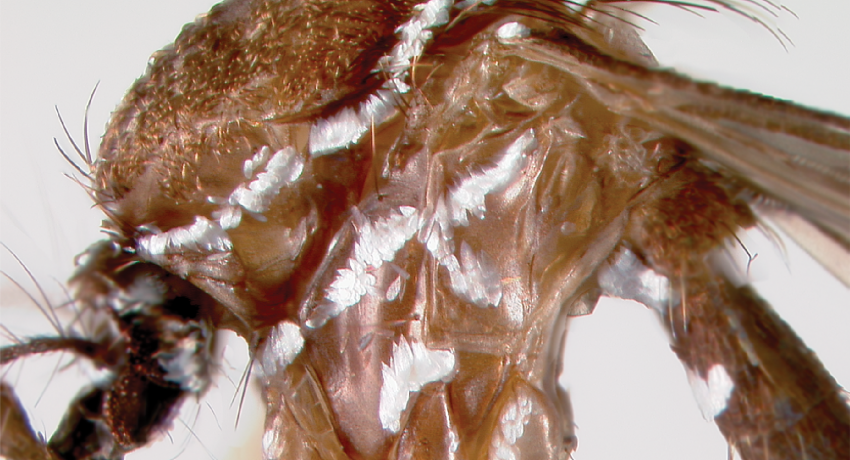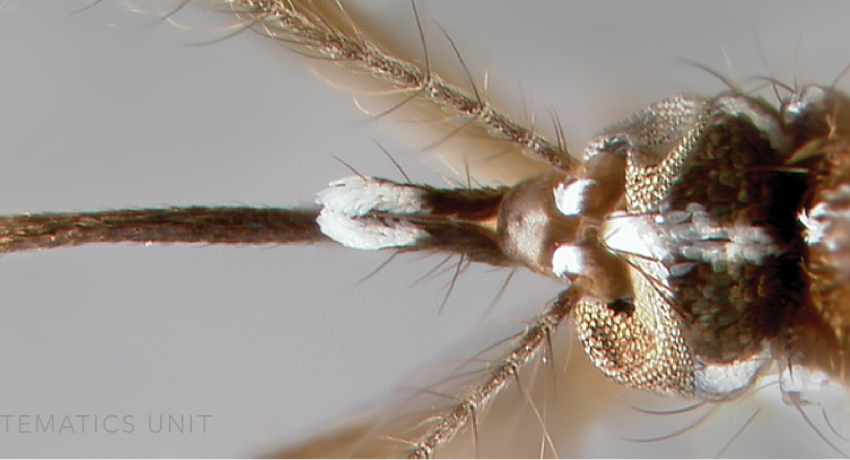AUSTRALASIAN REGION
Etymology: Polynesia
Aedes polynesiensis as a distinctive single wide stripe down the middle of its scutum and two distinct lines of silvery white scales across the lateral thorax. It is a member of the Scutellaris Group, and is an important vector of filariasis and a secondary dengue vector across its range. Genetic studies suggest that the species established in Polynesia with the arrival of people between 1500–3000 years ago, and population studies across its range supported human-assisted distribution patterns.
Type locality: Taveuni, Fiji Islands
Type depository: Natural History Museum, London, England, United Kingdom (NHMUK)
DIAGNOSTIC CHARACTERS (Click photos to view; mouse over and click large photo to zoom in.)
ADULT (illustrated): Head: Proboscis entirely dark-scaled; palpus with white scales at apex; pedicel with lateral and mesal scales. Thorax: Scutum with median silvery stripe; scutellar mid-lobe with broad white scales and dark apical scales; scales on antepronotum, postpronotum and paratergite; lower mesepimeral scales white; proepisternal white scale patch; subspiracular area without scales; supraalar scales as complete white line; antealar scales broad; costa with distinct silvery spot at base. Legs: Fe-II without anterior median white line; Fe-III with anterior broad white longitudinal stripe broadened on basal 0.3-0.5; Ta-III5 white.
LARVA (not illustrated): Head: Seta 1-A very small, weakly developed; seta 4-C prominent, many branched; seta 5-C single, at same level as 7-C; setae 4,6-C distinctly anterior to 7-C. Terminal segments: Comb scales in a single row, with fine fringe at base and spine-like apex; saddle (Sa) complete; seta 2-X usually 3-branched; 4 pairs of seta 4-X.
TAXONOMIC KEYS
Ramalingam 1976
Huang & Hitchcock 1980
Lee et al. 1987a
![]()
WRBU – Aedes – Australasian Region – Larva
Exemplar DNA sequences
Ae. polynesiensis ITS2: AY822661–62
BIONOMICS
Immatures
Aedes polynesiensis immatures develop in a wide variety of containers, including tree holes, banana stumps, leaf axils, coconut shells and husks, cacao pods, rock holes, banana stumps, and artificial containers, including tires, bottles, and canoes. Somewhat unusually within Stegomyia species, Ae. polynesiensis will also deposit eggs in small ground water habitats, including land-crab holes made by Cardisoma carnifex (Herbst, 1794) (Gecarcinidae).
Adults
Females readily bite humans during the day, peaking in the late afternoon and early morning. Mating usually takes place near the host. Female Ae. polynesiensis also readily mate with male Ae. albopictus (Skuse, 1895).
DISTRIBUTION NOTES
Australia, Cook Islands (Polynesia), Fiji, French Polynesia, Niue, Polynesian Islands; Howland; Jarvis; Johnston Atol; Pitcairn; Wallis & Futuna, Samoa (Ind. State of Samoa; American Samoa; Western Samoa), South China Sea Islands (Paracel, Spratly, Tokelau), Tahiti, Tuvalu.

WRBU VECTOR HAZARD REPORTS
None; View other WRBU Vector Hazard Reports
Available GIS Models
Ae_polynesiensis_Nyari_1 Global
IMPORTANT REFERENCES (full citations below)
Marks 1951a: 138 (M, L)
Marks 1954: 383, pl. 18 (M*, F*)
Rosen & Rozeboom 1954: 531 (L*)
Belkin 1962: 468 (M*, F, P*, L*)
Mattingly 1970g: 35 (L*)
Huang 1975a (M*, F*, P*, L*; taxonomy)
Ramalingam 1976: 304 (taxonomy, bionomics, keys, distribution; Samoa & Tonga)
Huang & Hitchcock 1980 (M*, F*, P*, L*; taxonomy, keys, distribution)
Lee et al. 1987a: 147 (F key, taxonomy, bionomics, distribution, review)
Linley & Service 1995 (E*)
CURRENT SYNONYMS
None
CITED REFERENCES
Belkin, J.N. (1962). The mosquitoes of the South Pacific (Diptera, Culicidae) (Vols. 1 & 2). Berkeley, California: University of California Press.
Huang, Y.-M. (1975a). A redescription of Aedes (Stegomyia) pseudoscutellaris (Theobald) with a note on the taxonomic status of Aedes (Stegomyia) polynesiensis Marks (Diptera: Culicidae). Mosquito Systematics, 7(1), 87–101.
Huang, Y.-M., & Hitchcock, J.C. (1980). Medical entomology studies - XII. A revision of the Aedes scutellaris group of Tonga (Diptera: Culicidae). Contributions of the American Entomological Institute, 17(3), 1–107.
Lee, D.J., Hicks, M.M., Griffiths, M., Debenham, M.L., Bryan, J.H., Russell, R.C., . . . Marks, E.N. (1987a). The Culicidae of the Australasian region. Volume 4. Commonwealth Department of Health, School of Public Health and Tropical Medicine Monograph Series, 2.
Linley, J.R., & Service, M.W. (1995). The eggs of Aedes polynesiensis and Aedes katherinensis (Diptera: Culicidae). Mosquito Systematics, 27(2), 143–152.
Marks, E.N. (1951a). The vector of filariasis in Polynesia: a change in nomenclature. Annals of Tropical Medicine and Parasitology, 45, 137–140.
Marks, E.N. (1954). A review of the Aedes scutellaris subgroup with a study of variation in Aedes pseudoscutellaris (Theobald) (Diptera: Culicidae). Bulletin of the British Museum (Natural History) (B), 3, 347–414.
Mattingly, P.F. (1970g). Mosquito larvae II. Some undescribed first stages. Mosquito Systematics Newsletter, 2(1), 34–36.
Ramalingam, S. (1976). An annotated checklist and keys to the mosquitoes of Samoa and Tonga. Mosquito Systematics, 8(3), 298–318.
Rosen, L., & Rozeboom, L.E. (1954). Morphologic variations of larvae of the scutellaris group of Aedes (Diptera, Culicidae) in Polynesia. American Journal of Tropical Medicine and Hygiene, 3, 529–538.
CITE THIS PAGE
Walter Reed Biosystematics Unit (Year). Aedes polynesiensis species page. Walter Reed Biosystematics Unit Website, http://wrbu.si.edu/vectorspecies/mosquitoes/polynesiensis, accessed on [date (e.g. 03 February 2020) when you last viewed the site].












































































































































































